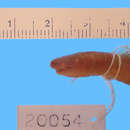Description
provided by AmphibiaWeb articles
Diagnosis: Shistometopum gregorii is a caeciliid that does not have the eye under bone. The eye socket is formed primarily by the squamosal; maxilla forms the anterior border. There is no temporal fossae. The mesethmoid is exposed dorsally between separated frontals. The tentacular aperture is closer to the eye than to external naris. Splenial teeth, secondary annuli, and scales are present. There is no unsegmented terminal shield, narial plugs, diastema between vomerine and palatine teeth, and terminal keel (Nussbaum and Pfrender 1998).Description: Both male and female adults range from 160 to 330 mm in snout-vent length (Harper et al. 2010). Total lengths for Shistometopum gregorii are between 150 mm and 350 mm. Average number of primary annuli is 114.3 for males and 114.5 for females (ranging from 110 to 119) (Harper et al. 2010; Nussbaum and Pfrender 1998). Average number of secondary annuli is 46. Average number of complete secondary annuli is about 11 (Nussbaum and Pfrender 1998). Small scales can be found in the skin. S. gregorii has visible eyes. (Channing and Howell 2006).Coloration: S. gregorii has a black body that is grey to brown throughout. The head is usually a shade of grey and is usually different from the body coloration. (Channing and Howell 2006; Harper et al. 2010).S. gregorii was first described by Boulenger 1894 (Frost 2011).S. gregorii was named for the geologist, J.W. Gregory who discovered the holotype (Channing and Howell 2006; Nussbaum and Pfrender 1998). The species was previously named Dermophis gregorrii and Bdellophis unicolor (Frost 2011). The two populations of S. gregorii might be distinct species. Cloaca in S. gregorii have similar morphology to that of S. thomense. Also, the mid-dorsal region of the phallodeum in two Tanzanian specimens of S. gregorii have a greater resemblance to the morphology of S. thomense than to the single, examined specimen of a Kenyan S. gregorii (Gower and Wilkinson 2002).
- Channing, A., and Howell, K. M. (2006). Amphibians of East Africa. Cornell University Press, Ithaca.
- Gower, D. J., and Wilkinson, M. (2002). ''Phallus morphology in caecilians (Amphibia: Gymnophiona) and its systematic utility.'' Bulletin of the Natural History Society of London (Zoology), 68, 143-154.
- Loader, S., Howell, K., Gower, D., Measey, J., and Wilkinson, M. (2004). Schistometopum gregorii. In: IUCN 2010. IUCN Red List of Threatened Species. Version 2010.4. www.iucnredlist.org. Downloaded on 14 April 2011.
- Nussbaum, R.A. and Pfrender, M.E. (1998). ''Revision of the African caecilian genus Schistometopum Parker (Amphibia: Gymnophiona: Caeciliidae).'' Miscellaneous Publications Museum of Zoology, University of Michigan, 187, 1-32.
- author
- Karen Sorenson
- author
- Yu-Huan Wu
- author
- Mary Watson
Distribution and Habitat
provided by AmphibiaWeb articles
S. gregorii is found in East Africa in the countries of Kenya and Tanzania. In Kenya, it is found in the Tana River Delta. In Tanzania, it is found in Bagamoyo. It has not yet been discovered in the area between the Tana River and Bagamoyo. It is associated with mudflats, water bodies, and can be abundant in agricultural land. It is found near sea level from 0 to 10 m. (Loader et al. 2004; Harper et al. 2010)
- author
- Karen Sorenson
- author
- Yu-Huan Wu
- author
- Mary Watson
Life History, Abundance, Activity, and Special Behaviors
provided by AmphibiaWeb articles
This species is generally fossorial. It is possible, although not known, that S. gregorii may enter aestivation during dry conditions. S. gregorii are known to be good swimmers. They might use this skill as a dispersal method (Harper et al. 2010). While little is known about reproduction in S. gregorii, it is a viviparous and most likely a precocial species. Adults eat soil macroinvertebrates such as earthworms and termites. (Channing and Howell 2006; Harper et. al. 2010).
- author
- Karen Sorenson
- author
- Yu-Huan Wu
- author
- Mary Watson
Life History, Abundance, Activity, and Special Behaviors
provided by AmphibiaWeb articles
The population trend is unknown. While there are no good population estimates and accounts of this species are rare, it is believed that because of their wide range and use of fairly stable habitats that S. gregorii is an abundant species. However, this species may suffer from future mechanical rice farming (Loader et al. 2004)
- author
- Karen Sorenson
- author
- Yu-Huan Wu
- author
- Mary Watson
Schistometopum gregorii
provided by wikipedia EN
Schistometopum gregorii, also known as Witu caecilian, mud-dwelling caecilian, and flood-plain-dwelling caecilian, is a species of amphibian in the family Dermophiidae from East Africa.[1][2]
Distribution
Schistometopum gregorii is endemic to the coastal East Africa in Kenya and Tanzania; it is known from the Tana River Delta area in Kenya (its type locality) and between Bagamoyo and Rufiji River in Tanzania.[2] It is possible that the Kenyan and Tanzanian populations are distinct species.[1]
Etymology
The specific name gregorii honours John Walter Gregory, a British geologist and explorer[3] and the collector of the holotype.[4]
Description
Schistometopum gregorii is glossy black dorsolaterally and somewhat lighter ventrally. There are 110–119 primary annuli (ring-shaped folds). Kenyan males measure 141–336 mm (5.6–13.2 in) (mean 247 mm) and females 152–350 mm (6.0–13.8 in) (mean 260 mm) in total length.[4]
Habitat and conservation
The species has been found from black mud near rivers and agricultural areas (e.g., rice paddies). There are no known major threats affecting this ecologically poorly known species. Because it occurs in cultivated areas it is likely able to tolerate disturbance.[1]
References

- license
- cc-by-sa-3.0
- copyright
- Wikipedia authors and editors
Schistometopum gregorii: Brief Summary
provided by wikipedia EN
Schistometopum gregorii, also known as Witu caecilian, mud-dwelling caecilian, and flood-plain-dwelling caecilian, is a species of amphibian in the family Dermophiidae from East Africa.
- license
- cc-by-sa-3.0
- copyright
- Wikipedia authors and editors

